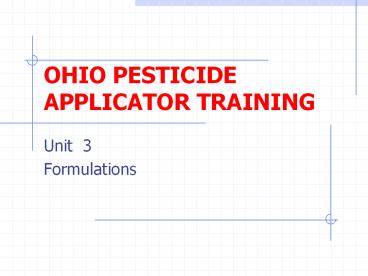OHIO PESTICIDE APPLICATOR TRAINING - PowerPoint PPT Presentation
1 / 24
Title:
OHIO PESTICIDE APPLICATOR TRAINING
Description:
OHIO PESTICIDE APPLICATOR TRAINING Unit 3 Formulations The Ohio State University Extension David J. Goerig Ag / Natural Resource Agent Mahoning County What is a ... – PowerPoint PPT presentation
Number of Views:131
Avg rating:3.0/5.0
Title: OHIO PESTICIDE APPLICATOR TRAINING
1
OHIO PESTICIDE APPLICATOR TRAINING
- Unit 3
- Formulations
2
The Ohio State University Extension
- David J. Goerig
- Ag / Natural Resource Agent
- Mahoning County
3
What is a Formulation?
- All the ingredients in a pesticide product.
- The Active Ingredients or Control Chemical
- The Inert ( Inactive) Ingredients.
- Usually formulations are diluted in water, a
petroleum-based solvent, or other diluents.
4
Types of Formulations
- LIQUIDS
5
Emulsifiable Concentrates(EC or E)
- ADVANTAGES
- DISADVANTAGES
Easy to handle, transport, and store.
High concentration.
Easily absorbed through skin.
Little agitation required.
Non abrasive.
Solvents may cause surfaces to deteriorate.
Do not plug screens or nozzles.
Flammable. May be corrosive
Little visible residue
6
Solutions (S)
- Dissolve readily in a liquid solvent.
- When mixed, forms a solution that will not
settle out or separate.
- Formulations of these pesticides usually contain
the active ingredient, the solvent, and one or
more other ingredients.
7
Ready to use (RTU)
- Pre-mixed pesticide products.
- Contain active ingredient and correct amount of
solvent.
- No further dilution is required.
- Often 1 or less of active ingredient.
8
Concentrate Solutions (C or LC)
- Must be further diluted.
- Mix readily, no agitation required.
- Limited number of formulations.
9
Ultra-Low-Volume (ULV)
- ADVANTAGES
- DISADVANTAGES
Relatively easy to handle, transport, and store.
High drift hazard
Specialized equipment required.
Little agitation required.
No plugging of screens and nozzles.
Easily absorbed through skin.
Not abrasive to equipment.
Solvents can deteriorate equipment parts.
10
Flowables (F or L)
- Insoluble solids mixed with water and other
inert ingredients to form a suspension.
- Easy to handle and apply.
- Require moderate agitation.
- May leave a visible residue.
11
Aerosols (A)
- ADVANTAGES
- DISADVANTAGES
Ready to use.
Practical for very limited uses.
Easily stored.
Risk of inhalation injury.
Convenient
Hazardous if punctured, overheated, or used near
open flame.
Retain potency
Difficult to confine to target site or pest.
12
Invert Emulsions
- Water soluble pesticide with an oil based
carrier.
- Form large droplets that do not drift easily.
- Commonly used in vegetation control along rights
of way.
13
Types of Formulations
- DRY
14
Dusts (D)
- ADVANTAGES
- DISADVANTAGES
No mixing, ready to use.
Easily drift off target
Requires simple equipment
Does not stick to surfaces.
Effective in hard-to reach indoor areas.
May irritate yes,nose, throat and skin.
Good choice where moisture from a spray would
cause damage.
Difficult to get even distribution of material
15
Baits (B)
- ADVANTAGES
- DISADVANTAGES
Ready to use
Can be attractive to children.
Selective site application
May kill non-target animals.
Control pests that move in and out of an area.
Dead pests may cause odor problem.
16
Granules (G)
- ADVANTAGES
- DISADVANTAGES
Ready to use, no mixing.
Does not stick on foliage
May need to be incorporated into soil.
Low drift hazard.
Little hazard to applicator.
May need moisture to activate.
Simple application equipment.
Hazardous to non-target species.
Slow- release
17
Pellets (P or PS)
- Similar to granular formulations
- All the particles are the same shape and size.
18
Wettable Powders (WP or W)
- ADVANTAGES
- DISADVANTAGES
Easy to store, handle, and transport.
Inhalation hazard to applicator while pouring and
mixing the concentrated powder.
Less likely than ECs and others to cause harm to
treated target.
Requires constant agitation in spray tank.
Easily measured and mixed.
Abrasive to many pumps and nozzles./ clogs
nozzles.
Less skin and eye absorption than ECs and other
liquids.
Residues may be visible.
19
Soluble powders (SP or WSP)
- Look like Wettable powders.
- Dissolve readily and form a true solution.
- Inhalation hazard.
- Few pesticides available in this form.
20
Microencapsulated Pesticides(M)
- ADVANTAGES
- DISADVANTAGES
Increased safety to applicator.
Constant agitation necessary in tank.
Easy to mix, handle, and apply.
Special honey bee risk.
Releases pesticide over a period of time.
21
Water-Dispersible Granules(Dry Flowables)(WDG or
DF)
- Similar to wettable powders.
- More easily measured and mixed.
- Less inhalation hazard during pouring and mixing.
22
Fumigants
- ADVANTAGES
- DISADVANTAGES
Toxic to a wide range of pests.
Target site MUST be enclosed to prevent gas from
escaping.
Can penetrate tight areas.
Highly toxic to all living organisms.
Requires specialized protective and application
equipment.
Single treatment will usually kill most pests.
23
Adjuvants / Surfactants
- Surface active ingredients
- Examples include Wetting Agents, Emulsifiers,
Invert Emulsifiers, SpreadStickers, Penetrants,
Foaming Agents, Thickeners, Safeners,
Compatibility agents, Buffers, Anti-foaming
agents.
24
References
- A guide for Private and Commercial Applicators
Bulletin 825
- APPLYING PESTICIDES CORRECTLY
- The Ohio State University Extension































